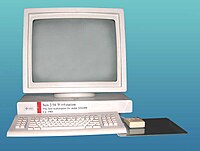Diskless node

Okay, so today we're going to talk about something called a diskless node. Imagine you have a computer or a device, like a game console, that needs to do some work, like open a program or play a video game. Normally, this computer has a part called a hard drive, which is like a really big storage box where all your files, programs, and games are kept.
But sometimes, instead of having its own hard drive, a computer can use what's called a diskless node. This means that it doesn't have its own storage box, or hard drive, but instead it gets all its information from a bigger box somewhere else, like a server.
So, let's say you wanted to play a video game on your diskless node computer. Instead of the game being stored on your computer's own hard drive, it would be stored on the server. When you start your game, your computer would ask the server for the game files, and the server would send them over to your computer through the internet.
This might seem kind of weird, because normally we're used to our computers having their own hard drives. But using a diskless node can have some benefits. For example, it can be a lot easier to manage lots of computers all at once if they're all using the same server for their files. It can also make it a lot quicker to set up new computers, because you don't have to worry about installing and setting up lots of different hard drives.
So that's a basic explanation of diskless nodes. Just think of them like computers that borrow their information from a big library instead of having their own storage boxes.
But sometimes, instead of having its own hard drive, a computer can use what's called a diskless node. This means that it doesn't have its own storage box, or hard drive, but instead it gets all its information from a bigger box somewhere else, like a server.
So, let's say you wanted to play a video game on your diskless node computer. Instead of the game being stored on your computer's own hard drive, it would be stored on the server. When you start your game, your computer would ask the server for the game files, and the server would send them over to your computer through the internet.
This might seem kind of weird, because normally we're used to our computers having their own hard drives. But using a diskless node can have some benefits. For example, it can be a lot easier to manage lots of computers all at once if they're all using the same server for their files. It can also make it a lot quicker to set up new computers, because you don't have to worry about installing and setting up lots of different hard drives.
So that's a basic explanation of diskless nodes. Just think of them like computers that borrow their information from a big library instead of having their own storage boxes.
Related topics others have asked about:
